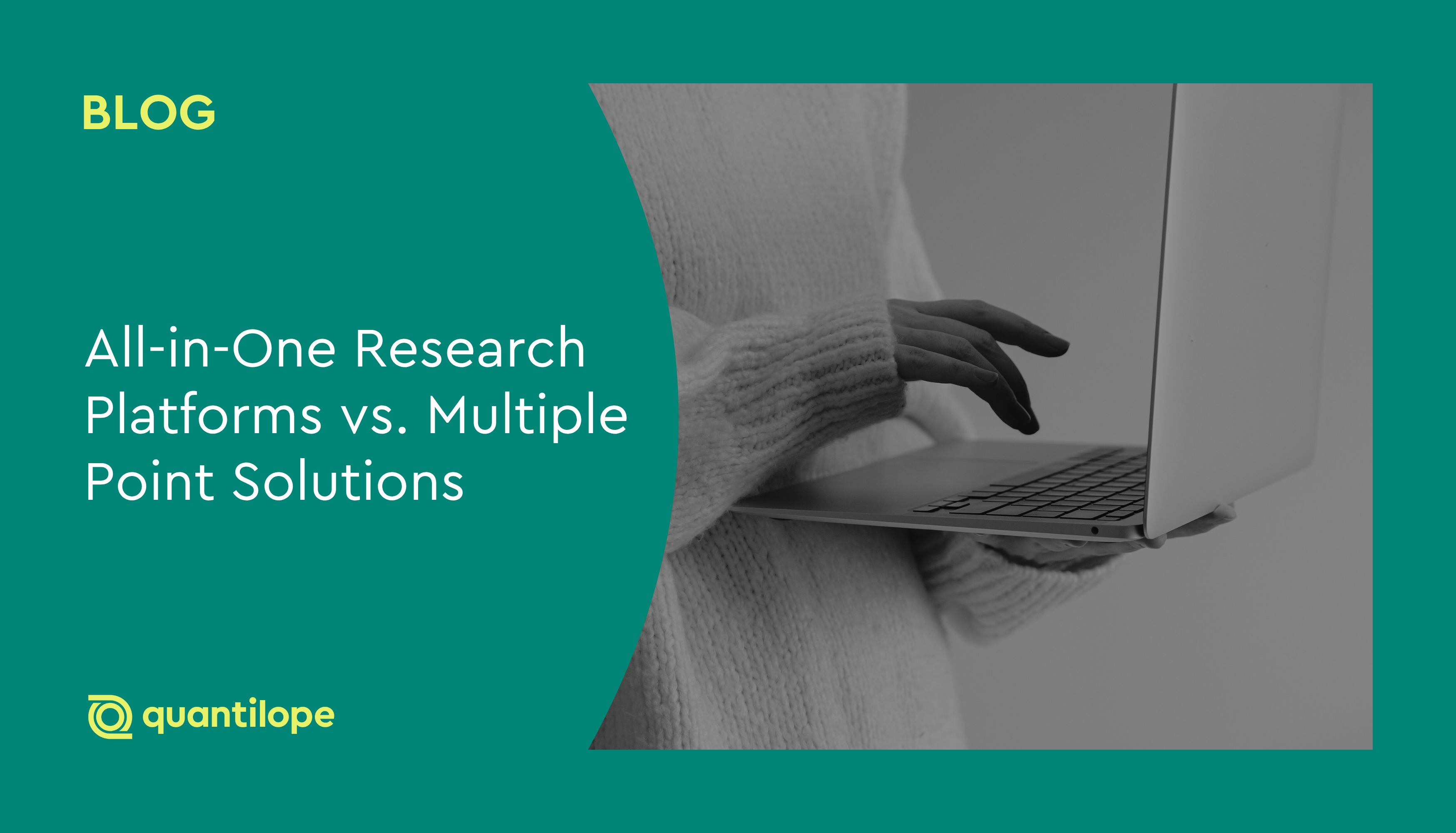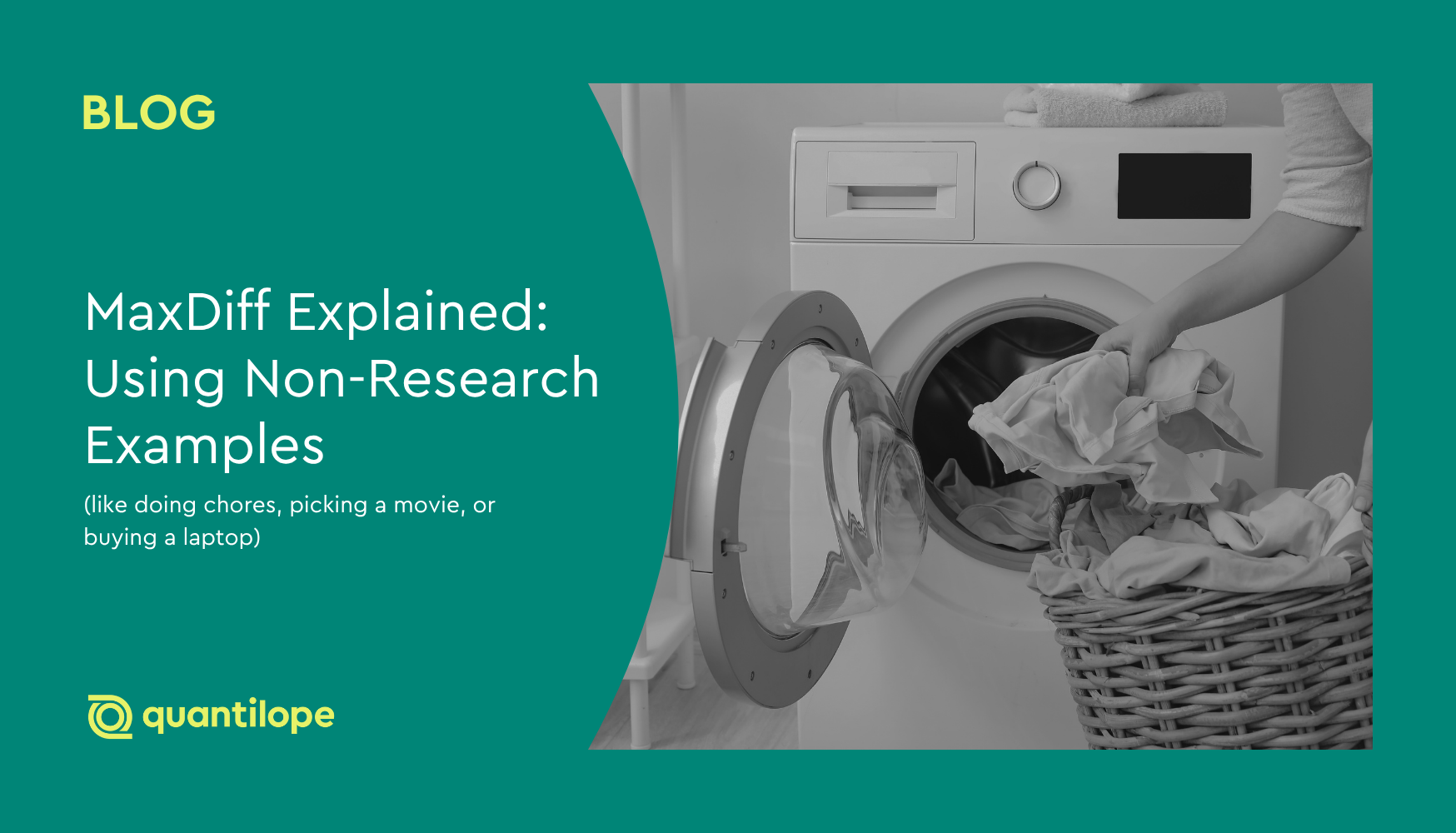In this article, we explore what traditional omnibus surveys are in market research and why they don’t work for providing high-quality, actionable, tailored insights about your target audience.
Table of Contents:
- What is an omnibus survey?
- Types of omnibus surveys
- Where do omnibus survey participants come from?
- 10 reasons why omnibus surveys aren't effective
- Run your own high-quality research just as fast as omnibus surveys with quantilope
What is an omnibus survey?
Omnibus surveys are a single survey that essentially acts as a ‘home base’ for a variety of questions - which makes sense given the origin of ‘omnibus’ to mean ‘for all/everyone’ in Latin. Questions in an omnibus questionnaire could be about all different topics, from various clients. As you can imagine, omnibus surveys are not very descriptive or useful for deep dives into a particular topic, but rather as a ‘question dump’ exploring many different areas. Oftentimes, clients will use this to test an initial hypothesis about a research question before drafting a full-scope questionnaire.
For example, the below questions might be shown to a respondent back-to-back in a single omnibus study:
-
How often do you purchase soda from the grocery store?
-
How many hours per week do you spend watching television?
-
What do you consider the most pressing issue in the upcoming presidential election?
-
When do you plan to take your next international vacation?
Types of omnibus surveys
Omnibus surveys come in a variety of formats, each tailored to address specific research needs:
-
Cross-sectional omnibus: This is the most common type of omnibus survey. It collects data from a diverse sample of respondents at a single point in time. It's great for understanding current opinions, behaviors, or trends.
-
Longitudinal omnibus: This type of omnibus involves surveying the same group of respondents multiple times over a period. This helps track changes in opinions or behaviors over time, allowing for insights into cause-and-effect relationships.
-
Targeted omnibus: These focus on specific demographics or groups of interest. This allows for deeper exploration of specific markets or customer segments.
-
Syndicated omnibus: These omnibus studies are conducted by market research firms who then sell the data to multiple clients. This can be cost-effective for companies who need general market data.
-
Custom omnibus: These are designed and conducted to answer very specific research questions. They offer high flexibility and control but can be more expensive.
Each type of omnibus survey has its strengths and weaknesses. The choice depends on the specific research objectives, budget, and timeline.
Back to Table of Contents
Where do omnibus survey participants come from?
Omnibus panel respondents typically come from online panels that are pre-recruited to participate in such studies. In this case, respondents might be chosen for certain demographics to ensure a representative sample or chosen for their high-quality responses. In other cases, omnibus participants could be recruited using specialized sampling methods such as convenience sampling (where participants are chosen simply based on who’s around or available) or systematic sampling (where every 'nth' respondent is chosen to participate).
The sample group for an omnibus study really all comes down to the research agency conducting it, which might have its own source of online panel participants who have opted in to receive these questionnaires. These participants sign up to take the surveys and often receive some sort of compensation in the form of reward points, gift cards, or cash.
Back to Table of Contents
10 reasons why omnibus surveys aren’t effective
Knowing what omnibus studies are, how they work, and where participants are sourced from, here are 10 reasons why omnibus surveys are not actually the most effective use of your research budget:
1. Omnibus surveys have a limited number of questions
As mentioned above, omnibus surveys will limit the number of questions each research team can add in, in order to maintain a positive respondent experience. That’s because if 20 different research companies wanted to add 15 questions, that ends up being a huge time commitment for respondents, and many will drop out due to respondent fatigue.
With this in mind, research firms need to carefully select the few questions they want to include in hopes they answer the overall research question at hand.
2. Omnibus surveys don’t allow for specific demographic cuts
Because respondents have to be general enough to apply to all participating research agency’s questions, you won’t get specific sample groups like ‘grocery shoppers’, ‘tech-adopters’, or ‘frequent travelers’. This could lead to responses in your dataset that don’t really answer your research question or provide enough detail to make a business decision. Metrics from your included questions among the general population could be vastly different from what your true target audience might report.
If you make business decisions based on omnibus insights, you might find that your new product launches or marketing material don’t effectively resonate with your buyers when you launch them in the market.
3. Omnibus surveys might be limited to a small sample size
Depending on your omnibus survey company, you might be limited to a small sample size. For example, some companies may only allow you to capture responses from 100 respondents, which might be enough for a quick read of data or to confirm/deny a hypothesis, but not enough to have reasonable base sizes when cut by other demographic data (like age, gender, or ethnicity if those were included in the omnibus survey screener).
Smaller base sizes also limit statistical analysis and reliability of the data, further making omnibus studies something to use as a general sense check rather than a study to make important decisions off of.
4. Omnibus surveys don’t offer customizable survey design
Because omnibus surveys are essentially a one-size fits all type of design, researchers don’t have the luxury of formatting question types to their liking, adding in graphics, or adding specific survey elements like they would in a classic research study. Research teams can typically ask basic quantitative survey questions like single/multiple choice or rating scales.
Some omnibus providers may offer the flexibility to include open-ended questions which would allow research teams to gather more detailed data from respondents.
5. Omnibus surveys can lead to lower respondent quality
Generally, you can expect a lower respondent quality from omnibus studies compared to personal research projects. When you run an omnibus study, you’re trusting that the omnibus agency has vetted respondents for high-quality respondent feedback. Compare this to your own research study where you can work with a panel provider to ensure the level of quality (and only pay for the high-quality responses you achieve) - resulting in a much better dataset. Similarly, because omnibus studies run in set waves to accommodate multiple sources (i.e. every day at 9 am EST), you can’t typically go back into fieldwork to capture additional completes that make up for poor-quality feedback.
Aside from the actual quality of the sample, you also have to consider potential research biases. Since you don’t know what other research firms are going to include in the study, there’s always the chance that their questions could impact the results of yours. For example, if one research company includes a question about brands of coffee grounds, and your research question asks about the frequency of drink consumption - coffee is already top of mind for respondents so they are more likely to over-report it.
6. Omnibus surveys don’t provide a great survey experience
Not only can omnibus surveys lead to poor-quality responses given how respondents are sourced, but it also doesn’t provide the greatest survey experience for participants in terms of flow. From the omnibus survey question examples above, if a respondent is asked questions back to back that make their mindset constantly shift gears, they may become frustrated or annoyed - and thus, give lesser quality answers than they would if focused on one topic with specific questions on that topic.
Imagine you are going through a survey that starts out asking about travel plans, then asks about pet food, then asks about home cleaning products. You would probably be pretty confused which could affect the way you respond to each question. Compare this to other studies where you can set the stage for a respondent, provide them with an introduction, and ease them into the questions going from general to more specific throughout the survey. In this case, the respondent is fully in the mindset of your topic and more likely to provide more detailed and well-thought-out responses.
7. Omnibus surveys don’t generate actionable deliverables
When you ask simple, basic survey questions, you get simple, basic data outputs. These basic charts won’t create as actionable or detailed of a deliverable for stakeholders as your own-commissioned study would.
When you run your own study and can dive into a topic from multiple angles, you’re able to craft a much more compelling story. You can cut your data points by other question variables, show metrics by different target audience groups, and explore relationships across your entire data set. When stakeholders have access to these rich insights with multiple data lenses, it’s easier for them to make data-supported business decisions than having to assume things from a basic omnibus chart.
8. Omnibus surveys don’t support advanced methodologies
As mentioned above about asking basic survey questions, omnibus studies are unlikely to accommodate advanced method data collection which includes questions like a MaxDiff, TURF analysis, Key Driver Analysis, or Segmentation.
Advanced method research is one of the best ways to dive into your target audience for the ‘why’ and ‘how’ behind many of their behaviors. For example, a MaxDiff can tell you how important certain features are for consumers, and a Key Driver Analysis can tell you why consumers make the decisions they do. When you have the option to include your own questions in your own-commissioned study that can ask these types of intricate details, you create a much stronger deliverable for your key stakeholders.
9. Omnibus surveys don’t show results in real-time
When you aren’t the owner of your research study (as is the case with omnibus studies, owned by the omnibus provider), you’ll have to wait until the close of fieldwork to actually view your results. Typically this isn’t a huge issue with omnibus studies, as they start and close fieldwork rather quickly, but you’re still left to rely on the provider to collect all the data, process it, and send it over depending on their timelines.
This type of process is less efficient than a survey platform where you can view results in real-time as soon as they come in. This allows you to act on a hypothesis immediately, tweak a survey design depending on how your omnibus questions are turning out, or inform your team whether or not to even proceed with a new product or business idea. In research, time is of the essence and while omnibus studies may be quick, the results aren’t guaranteed to be quick as well.
10. Omnibus surveys are not cost-effective
A research budget is valuable and insights teams need to be smart about where they spend it. When you spend that budget on an omnibus survey, you aren’t getting the most value out of your consumer insights. Typically you’ll get feedback to just a handful of general questions, often leading you to have even more questions about consumer behavior than when you started (i.e. ‘Why did consumers say they only shop for soda once a month?, or, ‘What kind of transportation and hotel accommodations do international travelers plan to book?’).
With these further questions, your team is left to run yet another research study (with additional pricing) to get to the bottom of it. Instead, running that study yourself on a real-time insights platform could have been a one-stop shop that answered all questions in one go-around rather than commissioning two separate studies.
Back to Table of Contents
Run your own high-quality research just as fast as omnibus surveys with quantilope
When you become a user of quantilope’s Consumer Intelligence Platform, you have an end-to-end solution for all your market research needs. Collaborate across teams in the platform’s manage section or by tagging colleagues into questions, build your custom survey by starting with a template or the drag & drop library of descriptive and advanced method questions, monitor results in real-time, and build your charts and dashboard before fieldwork even wraps up. Include as many questions as you like - without the risk of question bias due to other research teams’ questions. You own the survey and decide what makes up the final questionnaire for respondents.
When you’re looking for quick, actionable, high-quality data among your target group, swap your online omnibus survey for a tailored study on quantilope’s platform with results just as fast (if not quicker).
Get in touch below to learn more about quantilope’s platform and to start gathering better consumer insights!




